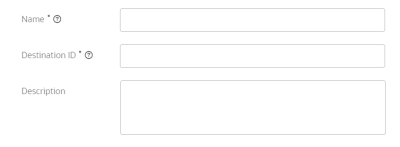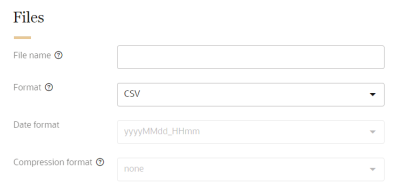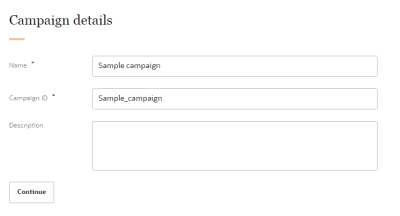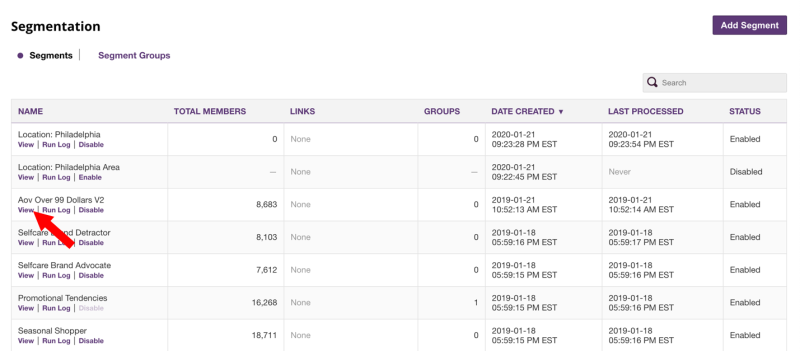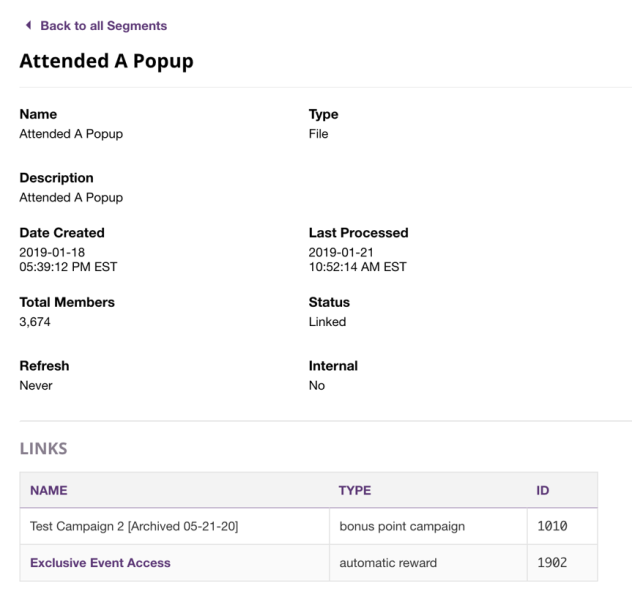Setting up the export of data to Oracle CrowdTwist
Exporting Oracle Unity segments to Oracle CrowdTwist allows you to deliver a personalized member experience to your customers. These segments can be used in CrowdTwist to deliver the following:
Learn more about Segmentation from the Oracle CrowdTwist Help Center.
Before you begin
Before you start exporting data to CrowdTwist, you will need to contact your CrowdTwist account manager so that the Secure FTP (SFTP) location can be set up to receive Oracle Unity segments.
When the SFTP location is ready, your account manager will send the details needed to configure the data export.
Review the following requirements for files exported to CrowdTwist.
- Naming convention of files : SegmentName_YYYYMMDD_HHMM. The timestamp is in 24-hour format.
- Supported file type : CSV.
- The file has two headers, ID and CTUserID. The headers are case sensitive.
CrowdTwist will do the following validations on the exported files.
- The CSV file has the correct naming convention and each row has one user entry.
- Duplicate entries will be removed.
- New lists of users will be created when a new file is exported with a new timestamp.
- The maximum file size is 128 MB.
- If a CTUserID doesn't exist on the CrowdTwist platform, the user will be stored without any validation.
Setting up the export of data to CrowdTwist requires the following tasks:
- Create a CrowdTwist destination
- Create a CrowdTwist segment delivery (You have the option of creating a segment delivery or export job to send the data out of Oracle Unity. These steps focus on creating a segment delivery.)
Create a CrowdTwist destination
The first step in setting up the data export is to create a destination.
To create a CrowdTwist destination:
-
Click the Oracle icon
 in the bottom-right corner to open the navigation menu.
in the bottom-right corner to open the navigation menu.
- Select Destinations.
- In the top-right corner, click Create destination.
Step 1: Define destination details
The job details section allows you to define the type of destination and how it will display in Oracle Unity.
Enter the information for the destination.
- Type: Use the drop-down list to select CrowdTwist.
- Name: Enter a name. The name must be 1 or more characters, up to a maximum of 50. Use only letters (a–z and A–Z), numbers (0–9), underscores (_), hyphens (-), and spaces. The first character cannot be a space.
-
Destination ID: The unique system identifier that is auto-populated from the destination name you enter. You can't change this value after you create the destination.
- Description: Enter a description. This field is optional, but it is highly recommended to add descriptions for any entity created. This helps all other users get additional context when using and navigating Oracle Unity. The description can have a maximum of 512 characters with no restrictions on characters used. You can use characters from all languages supported in the language settings.
Step 2: Configure server settings
Important: When defining the authentication settings, make sure that one of the approved algorithms below is used to access the destination. If one of these algorithms is not used, Oracle Unity will not be able to successfully connect to the destination.
| Algorithm type | Algorithm |
|---|---|
| Cipher | aes256-ctr |
| Cipher | aes192-ctr |
| Cipher | aes128-ctr |
Configure the server settings for the segment delivery.
- SFTP server name: Enter the hostname for your organization's SFTP server. This field requires a user name and host name, formatted as username@sftpserverhostname.com.
- Authentication key: Select the file that has the authentication key needed to access the SFTP server. Oracle Unity will process the file and display the authentication key.
- Oracle Unity only supports private authentication keys in RSA format. You can't upload a public authentication keys.
- To create an RSA authentication key, learn how to Generate SSH Keys in PEM Format to Connect to a Public or On-Premises sFTP Server from the Using the FTP Adapter with Oracle Integration Help Center.
- Folder name: Enter the path name to the folder on the SFTP server where Oracle Unity should export files to.
Once you enter all the details, click Verify connection to ensure that Oracle Unity can access the server.
If there are connection issues, it could be for one of the following reasons:
- An incorrect SFTP server name.
- An incorrect authentication key.
- An incorrect Folder name.
If you still encounter connection issues, contact your IT administrator for further investigation.
Step 3: Configure file settings
The files details section defines the format of the destination files.
- File name: Enter the file name and extension to use for the exported files. A timestamp and file number will be added as a suffix identifying when the file was created. The timestamp will be in the format yyyy-MM-dd-HH-mm-ss-SSS. You can use characters from all languages supported in the language settings.
- Format: The format of the exported file must be in CSV format. Fields in the exported file will be separated by commas.
- Date format: The date format must be yyyyMMdd_HHmm.
- Compression format: Files for the CrowdTwist destination type can't be compressed. They will be exported in CSV format.
Example: If you enter the file name as Export_file_01, a timestamp will be added as a suffix and the file will be named Export_file_01_2021-05-12-12-56-12-926_0.csv. The timestamp is 2021-05-12-12-56-12-926. The "0" indicates it is the first exported file with the same timestamp.
Step 5: Save and publish the new destination
When finished defining the destination, scroll to the top of the page and click Save or Save and close.
Once you create the destination, you will need to publish the changes.
Create a CrowdTwist segment delivery
After creating and publishing the destination, you can create the segment delivery.
To create the segment delivery:
-
Click the Oracle icon
 in the bottom-right corner to open the navigation menu.
in the bottom-right corner to open the navigation menu.
- Select Segment Deliveries.
- In the top-right corner, click Create segment delivery.
The Create segment delivery page is displayed.
Step 1: Define segment delivery details
The segment delivery details section allows you to define how the segment delivery will display in Oracle Unity.
To define the segment delivery details:
- Enter the details for the segment delivery.
- Name: Enter a name. The name must be 1 or more characters, up to a maximum of 30. Use only letters (a–z and A–Z), numbers (0–9), underscores (_), hyphens (-), and spaces. The first character cannot be a space.
-
Campaign ID: The unique system identifier for your campaign. You can't change this value after you create the campaign.
- If the campaign name uses English characters, the Campaign ID field is auto-populated from the campaign name you enter. You can change this value before the campaign is created.
- If the campaign name uses characters from another language supported in the language settings, the Campaign ID field will be left blank. You will need to enter a name using English characters.
- Description: Enter a description. This field is optional, but it is highly recommended to add descriptions for any entity created. This helps all other users get additional context when using and navigating Oracle Unity. The description can have a maximum of 512 characters with no restrictions on characters used. You can use characters from all languages supported in the language settings.
- Click Continue.
Step 2: Select destination
You will select the CrowdTwist destination you created earlier.
To select the destination:
- Select the CrowdTwist destination.
- Enter a file name for the exported file.
- Click Verify connection to ensure that Oracle Unity can access the destination.
- After verifying the connection, click Continue.
Step 3: Select segment
You will select the segment you want to export to CrowdTwist.
- The only two personalization attributes for the segment are ID and CTUserID.
- If an alias is used for the CTUserID attribute, it needs to be exactly CTUserID and is case-sensitive.
If these configurations are not followed, then CrowdTwist will not be able to process the segment successfully.
To select a segment:
- Search by the segment name and click
 . Then, select the segment. The personalization attributes for the segment will display.
. Then, select the segment. The personalization attributes for the segment will display. - Review the details for the segment and click Continue.
Step 4: Schedule and notify
You will need to configure the schedule and notification settings for the segment delivery.
To schedule the segment delivery and define the notification settings:
- Configure the schedule for the segment delivery:
- Click Recurring to automatically run the segment delivery job on a regular schedule.
- Click On demand to run the segment delivery job as needed.
- If the segment delivery job is recurring, select the Frequency, Start time, and Days it will run.
- In the field for Notify, enter the email addresses of people to be notified when the segment delivery job runs. Separate multiple emails with a comma.
- If you only want a notification if the segment delivery job fails, click the checkbox Only notify on failure.
Step 5: Save and publish the segment delivery
After saving the segment delivery you will need to publish the changes before it can run.
To save and publish the segment delivery:
- Scroll to the top of the page and click Save or Save and close.
- Follow the steps for Publishing changes.
Using Oracle Unity segments in CrowdTwist
Use the CrowdTwist Control Center to manage your programs, activities, and rewards for Oracle Unity segments.
Visit the Segmentation area of CrowdTwist to view all segments. To view the details on a specific segment, click View.

